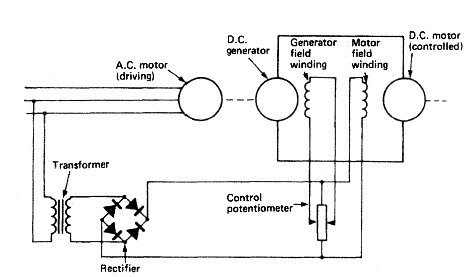Motor speed control

Fig: Ward-Leonard speed control
As a very flexible, reliable means of motor speed control the Ward-Leonard system is unmatched.
The system is made up of a driving motor which runs at almost constant speed and powers a d.c. generator . The generator output is fed to a d.c. motor. By varying the generator field current its output voltage will change. The speed of the controlled motor can thus be varied smoothly from zero to full speed. Since control is achieved through the generator shunt field current, the control equipment required is only for small current values. A potentiometer or rheostat in the generator field circuit enables the variation of output voltage from zero to the full value and also in either direction. The controlled motor has a constant excitation: its speed and direction are thus determined by the generator output.
Depending upon the particular duties of the controlled motor, series windings may be incorporated in the field of the motor and also the generator. This may result in additional switching to reverse the controlled motor depending upon the compounding arrangements. The driving motor or prime motor for the Ward Leonard system can be a d.c. motor, an a.c. motor, a diesel engine, etc. Any form of constant or almost constant speed drive can be used, since its function is only to drive the generator.

Fig: Ward-Leonard speed control
As a very flexible, reliable means of motor speed control the Ward-Leonard system is unmatched.
The system is made up of a driving motor which runs at almost constant speed and powers a d.c. generator . The generator output is fed to a d.c. motor. By varying the generator field current its output voltage will change. The speed of the controlled motor can thus be varied smoothly from zero to full speed. Since control is achieved through the generator shunt field current, the control equipment required is only for small current values. A potentiometer or rheostat in the generator field circuit enables the variation of output voltage from zero to the full value and also in either direction. The controlled motor has a constant excitation: its speed and direction are thus determined by the generator output.
Depending upon the particular duties of the controlled motor, series windings may be incorporated in the field of the motor and also the generator. This may result in additional switching to reverse the controlled motor depending upon the compounding arrangements. The driving motor or prime motor for the Ward Leonard system can be a d.c. motor, an a.c. motor, a diesel engine, etc. Any form of constant or almost constant speed drive can be used, since its function is only to drive the generator.
No comments:
Post a Comment